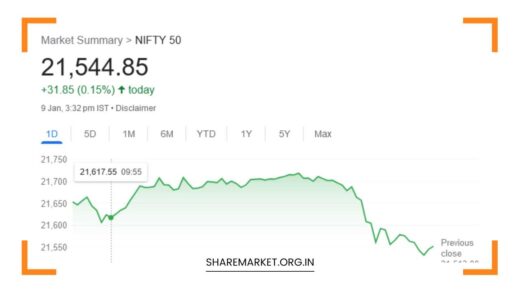Sensex Down 241 Points, Nifty at 23,453; Tomorrow Nifty Prediction

Tomorrow Nifty Prediction
Sensex and Nifty End in the Red: What to Expect on November 19
Indian stock markets ended the trading day on a negative note, continuing their bearish streak for the seventh consecutive session.
The persistent weakness in sectors such as Information Technology (IT), oil & gas, and telecom weighed heavily on market sentiment.
Despite this, some positive movement in select sectors like metals, automobiles, and real estate provided a glimmer of hope, helping the indices recover slightly from their lower levels.
Market Recap:
On Monday, November 18, the Indian equity market opened on a weak note, and the selling pressure continued throughout the session.
The Sensex closed at 77,339, down 241 points, while the Nifty finished at 23,454, a loss of 79 points.
The broader market was mixed, with the Midcap index managing a marginal gain of 2 points, ending at 54,045, while the Nifty Bank index posted a strong recovery, gaining 184 points to close at 50,363.
On the sectoral front, the performance was diverse. IT stocks bore the brunt of investor concerns, as the Nifty IT index fell by over 2%, following weak earnings reports and muted growth expectations.
Similarly, the oil & gas sector also saw a decline due to volatile crude prices and some earnings disappointments from key players in this space.
On the other hand, the metal index rose by over 1.8%, bolstered by a positive development from China, which decided to reduce tax exemptions on aluminum and copper.
This sparked a rally in metal stocks, which outperformed the broader market. Auto and realty stocks also saw buying interest, with both indices closing higher by small margins, reflecting investor confidence in select sectors.
Despite these gains in some sectors, the market breadth was negative. Out of the 30 stocks in the Sensex, 16 closed lower, while 29 out of 50 Nifty stocks were in the red.
However, there was some relief in the banking sector, where 9 out of 12 Nifty Bank stocks closed higher, led by strong performances from select private banks.
The Indian rupee remained stable at Rs 84.39 per dollar, closing unchanged from the previous session. This stability in the currency amid ongoing market volatility was seen as a positive sign.
Sectoral Performance:
1. IT Sector: The IT sector was among the biggest losers of the day, with the Nifty IT index falling more than 2%. The decline was attributed to several factors, including lower-than-expected earnings from major players and a general slowdown in demand for IT services.
Additionally, concerns about the global economic slowdown and a stronger dollar weighed on investor sentiment.
Analysts have pointed out that growth expectations for IT companies are now muted, especially as the global tech landscape faces challenges such as inflationary pressures, rising interest rates, and a slowdown in tech spending.
2. Oil & Gas: The oil & gas sector also witnessed weakness on Monday. Global oil prices have been volatile recently, and domestic companies have been facing margin pressures due to fluctuating crude prices.
Some earnings reports from major oil and gas companies were weaker than expected, further dampening sentiment.
While crude prices have been recovering in recent weeks, the broader outlook for the sector remains uncertain, particularly in light of global geopolitical tensions and ongoing supply-demand imbalances.
3. Metals: The metal sector was the standout performer of the day. The Nifty Metal index rose by 1.8%, driven by news that China had decided to reduce tax exemptions on aluminum and copper.
This move is expected to support the prices of these metals globally. Indian metal stocks, particularly those in the aluminum and copper segments, saw significant gains, with investors optimistic about the long-term prospects of the sector.
Additionally, the global demand for metals, particularly from infrastructure and green energy projects, remains strong, further adding to the positive outlook for metal companies.
4. Auto and Realty: Both the auto and realty sectors showed positive momentum, despite the broader market weakness.
The auto index rose on the back of strong sales figures from leading automakers, while the realty sector benefited from continued demand for residential and commercial real estate in key urban markets.
The auto sector continues to be a bright spot in the Indian economy, with robust demand for passenger vehicles, electric vehicles (EVs), and two-wheelers.
The real estate sector also appears to be on a recovery path, aided by lower interest rates and the ongoing urbanization trend.
Market Prediction and Expert Views:
Srikant Chauhan, Head of Equity Research at Kotak Securities, highlighted that the market has been under selling pressure due to weakness in key sectors such as IT, oil & gas, and telecom.
He pointed out that the Nifty closed 79 points lower, while the Sensex dropped 241 points. Chauhan observed that the market is currently trading below its 200-day Simple Moving Average (SMA), which is generally seen as a bearish signal.
Additionally, the formation of a bearish candlestick pattern on the daily chart suggests that the market could face more pressure in the short term.
However, he remains cautiously optimistic about a potential pullback rally. According to Chauhan, the market is currently oversold, which increases the probability of a short-term recovery.
He expects support levels at 23,350 for Nifty and 77,950 for Sensex. If these levels hold, the market could see a bounce back, with the Nifty possibly reaching 23,600 and the Sensex moving towards 78,000.
Further upside could take the Nifty to 23,700 and the Sensex to 78,200. However, if the support levels break, the market could witness further declines, with the Nifty potentially dropping to 23,200–23,175 and the Sensex slipping to 76,500–76,400.
Prashant Tapase, Senior Analyst at Mehta Equities, also agreed that the market’s weak performance is largely driven by IT, oil & gas, and telecom stocks.
He noted that foreign institutional investors (FIIs) have been withdrawing capital from Indian equities for the past month, which has further contributed to the bearish sentiment.
Tapase emphasized that rising US bond yields and weak earnings in the second quarter have created uncertainty among investors.
Vinod Nair, Head of Research at Geojit Financial Services, added that the market is in a phase of consolidation, with the weak rupee and slow earnings growth impacting investor sentiment.
Nair highlighted that the IT sector’s underperformance is linked to global factors, including the Federal Reserve’s stance on interest rates.
The delay in anticipated rate cuts could affect the BFSI (Banking, Financial Services, and Insurance) sector, which has been a key driver of the market in recent months.
What to Expect on November 19:
Looking ahead to November 19, the outlook for the markets remains cautious, with the potential for a short-term recovery if the support levels hold.
Global factors such as the direction of US interest rates and developments in the global economy will continue to play a key role in shaping market sentiment.
Domestically, earnings season will remain a focal point, with investors keen to see how sectors such as IT, banking, and metals report their numbers.
In conclusion, while the short-term outlook for the markets remains uncertain, there is a possibility of a pullback rally if support levels hold.
Traders should keep a close watch on key levels, including 23,350 for Nifty and 77,950 for Sensex, as these will provide important cues for the next direction in the market.

















